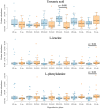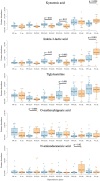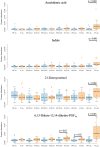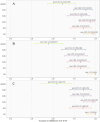Non-invasive giant panda pregnancy and pseudopregnancy biomonitoring by integrated metabolomics and steroidomics
- PMID: 41062782
- PMCID: PMC12508468
- DOI: 10.1038/s41598-025-19067-7
Non-invasive giant panda pregnancy and pseudopregnancy biomonitoring by integrated metabolomics and steroidomics
Abstract
Understanding the reproductive biology of giant pandas is crucial for their breeding success and conservation. Pregnancy monitoring, however, is challenging due to delayed implantation and obligatory pseudopregnancy, which limits the effectiveness of traditional immunoassays (IA). To remedy this, we combined polar metabolomics and steroidomics to enable a comprehensive view of the urinary molecular composition across six different reproductive phases spanning six pregnant and seven pseudopregnant cycles. Statistical comparisons revealed 696 discriminative features, including 174 features in the early luteal stages, well before the current pregnancy diagnostic window. Pregnant and pseudopregnant cycles showed differences in amino acid, energy, and steroid metabolism before and after CL reactivation, with androgen levels being significantly elevated in pregnant females specifically, suggesting a role in embryo implantation. Interestingly, we detected only one existing IA target metabolite, but identified other discriminative metabolites that may underlie IA signal detection. Finally, we demonstrated that classification models comprising biomarker panels may improve (early) pregnancy diagnosis with accuracies ranging from 0.763 to 1.000 across reproductive phases. These findings offer possibilities for assigning new biomarkers and optimizing IA target selection, thereby enhancing pregnancy monitoring sensitivity and reliability while improving our understanding of giant panda reproductive biology to support conservation efforts.
Keywords: Ailuropoda melanoleuca; Endocrine monitoring; Metabolomics; Pregnancy; Steroidomics; UHPLC-HRMS.
© 2025. The Author(s).
Conflict of interest statement
Declarations. Competing interests: The authors declare no competing interests.
Figures





References
-
- Kang, D. et al. Feeding habitat characteristics of giant pandas at different scales: A case study in the Wanglang nature reserve. Glob Ecol. Conserv.17, e000542 (2019).
-
- Zeng, Y. et al. Feeding habits and foraging patch selection strategy of the giant panda in the Meigu Dafengding National nature reserve, Sichuan province, China. Environ. Sci. Pollut Res.30, 49125–49135 (2023). - PubMed
-
- Swaisgood, R. R., Zhou, X., Zhang, G., Lindburg, D. G. & Zhang, H. Application of behavioral knowledge to conservation in the giant panda. Int. J. Comp. Psychol.16, 65–84 (2003).
MeSH terms
Substances
Grants and funding
LinkOut - more resources
Full Text Sources

